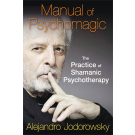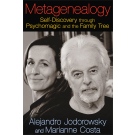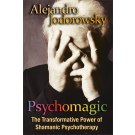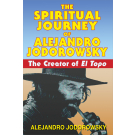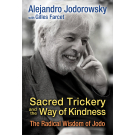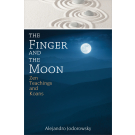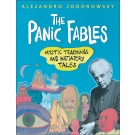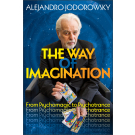The Way of Tarot
The Spiritual Teacher in the Cards
- Pages: 552
- Book Size: 6 x 9
- ISBN-13: 9781594772634
- Imprint: Destiny Books
- On Sale Date: November 17, 2009
- Format: Paperback Book
- Illustrations: Includes 8-page color insert and 544 b&w illustrations
• Works with the original Marseille Tarot to reveal the roots of Western wisdom
• Provides the key to the symbolic language of the Tarot’s “nomadic cathedral”
• Transforms a simple divination tool into a vehicle for self-realization and healing
Alejandro Jodorowsky’s profound study of the Tarot, which began in the early 1950s, reveals it to be far more than a simple divination device. The Tarot is first and foremost a powerful instrument of self-knowledge and a representation of the structure of the soul.
The Way of Tarot shows that the entire deck is structured like a temple, or a mandala, which is both an image of the world and a representation of the divine. The authors use the sacred art of the original Marseille Tarot--created during a time of religious tolerance in the 11th century--to reconnect with the roots of the Tarot’s Western esoteric wisdom. They explain that the Tarot is a “nomadic cathedral” whose parts--the 78 cards or “arcana”--should always be viewed with an awareness of the whole structure. This understanding is essential to fully grasp the Tarot’s hermetic symbolism.
The authors explore the secret associations behind the hierarchy of the cards and the correspondences between the suits and energies within human beings. Each description of the Major Arcana includes key word summaries, symbolic meanings, traditional interpretations, and a section where the card speaks for itself. Jodorowsky and Costa then take the art of reading the Tarot to a depth never before possible. Using their work with Tarology, a new psychological approach that uses the symbolism and optical language of the Tarot to create a mirror image of the personality, they offer a powerful tool for self-realization, creativity, and healing.
Chapter Six
L’Amoureux / The Lover
Union, Emotional Life
The name of this card is not, as often thought, The Lovers plural, but The Lover, singular. However, on it we see four human-shaped figures (the three individuals and the angel) and, if we really want, two entities that are the Earth and the Sun. Among them, who is The Lover? The central figure that is often interpreted to be a young man? The figure on the left, who some view as a transvestite? Or even the angel, the little Cupid aiming his arrow out of the sky? These questions arise because Arcanum VI is, along with The Tower, one of the most ambiguous cards of the Tarot, and one of those that is most poorly understood. VI represents in Tarot numerology the first step into the square of Heaven. It is the time when we stop imagining what would please us and begin doing what we like.
The major tone of this card concerns pleasure and emotional life. This is the very reason why it is so complex and so rich in conflicting meanings. It opens the field to countless projections, and a thousand meanings can be attributed to it, each of which can be right at a given moment. What is taking place with this trio? Is it a quarrel, haggling, a choice, a union? The two figures on the left are looking at each other while the one on the right is looking off into space. The whole of humanity can be comprehended through this card. The relations of its protagonists are extremely ambivalent.
Key words
Eros, Heart, Choice, Emotional Domain, Conflict, Ambiguity, Trio, Social Life, Community, Siblings, Doing What You Love...
The position of these figures’ hands is extremely interesting to observe. Five hands in various positions symbolize the complexity of the relationships in play. The first figure, on the left, has placed her hand on the second one’s shoulder in a gesture of protection or domination, either pushing him forward or holding him back. Her right hand is touching the hem of the boy’s tunic. The movement of her extended index finger can be interpreted as a desire to slide over to his penis or, to the contrary, a prohibition on doing so. The boy has his right hand pressed against his belt. In passing, we should note that this yellow belt has three bands and is the same as that worn by the woman on the left. But who is the owner of the arm touching the belly of the young woman? She and the boy both are wearing clothes with deep blue sleeves that are so closely matched it makes the movement of this arm ambiguous. In some way they make this a “commonly shared arm.” While the young man is touching the young woman’s belly close to her genitals, his gaze is directed away from her toward his right. The card will have an entirely different meaning if we consider this arm to be her own arm protecting or pointing toward her belly while the boy is holding his arm behind his back.
The woman on the right is wearing a headdress consisting of four five-petal flowers. It could represent a splendid awareness, poetic yet nevertheless solid. The violet heart of the flowers concentrates the wisdom of love, truly the ability to sacrifice oneself. The woman on the left is wearing a crown of green leaves; it is active (the red band), and if we agree that these are laurel leaves, we could say that she has the mentality of a victor or a dominatrix.
We can speculate infinitely on the relationship of the three figures: a boy presenting his fiancée to his mother; a woman discovering her husband with his mistress; a man attempting to choose between two women, or, as the traditional interpretation views it, between vice and virtue; a pimp offering a prostitute to a passerby; a young girl asking her mother for permission to wed the boy she has chosen; a mother in love with her daughter’s lover; a mother preferring one of her two children over the other, and so forth.
The interpretations are inexhaustible. All of them lead us to the conclusion that The Lover is a relational card that depicts the beginning of social life. It is the first Arcanum on which several individuals are presented at the same level (The Pope’s disciples are smaller than he is and seen from the back). This is a card of union and disunion, of social and emotional choices. Several clues present in the card direct us toward the notion of union. On the one hand, the sixth letter of the Hebrew alphabet, Vav (the nail), represents union. On the other hand, we can see patches of color (light blue then red) between these individuals’ legs that also represent a continuity, a union between them. On the symbolic plane, we could say that the three figures represent the governing centers of the human being: the intellect, the emotional center, and the sexual center joining together to become one.
The ground beneath these individuals’ feet has been plowed. This means that in order to reach the VI, it is necessary to have performed some preliminary psychological, cultural, and spiritual work. This is how we manage to realize what we love and what we want. The red shoes of the central figure are the same as those worn by The Fool and The Emperor; they can be considered as three stages of the same being. It can also be noted that the ground ends between this figure and his neighbor on the right, there is only the red patch. We can then see them as representations of the animus and the anima, two masculine and feminine aspects of one single person.
Preface by Marianne Costa
Introduction by Alejandro Jodorowsky
PART ONE
Structure and Numerology of the Tarot
Opening: The Tarot Is a Complete Entity
To Begin
Composition and Rules of Orientation
The Numerology of the Tarot
The Ten Stages for Constructing the Mandala
The Eleven-Color Scale
PART TWO
The Major Arcana
Opening: An Architecture of the Soul
To Begin
Le Mat/The Fool
I Le Bateleur/The Magician
II La Papesse/The High Priestess
III L’Impératrice/The Empress
IIII L’Empereur/The Emperor
V Le Pape/The Pope
VI L’Amoureux/The Lover
VII Le Chariot/The Chariot
VIII La Justice/Justice
VIIII L’Hermite/The Hermit
X La Roue de Fortune/The Wheel of Fortune
XI La Force/Strength
XII Le Pendu/The Hanged Man
XIII L’Arcane sans Nom/The Nameless Arcanum
XIIII Tempérance/Temperance
XV Le Diable/The Devil
XVI La Maison Dieu/The Tower
XVII L’Étoile/The Star
XVIII La Lune/The Moon
XVIIII Le Soleil/The Sun
XX Le Jugement/Judgment
XXI Le Monde/The World
PART THREE
The Minor Arcana
Opening: The Humble Guardians of the Secret
To Begin
The Degrees of the Numerology
- The Aces
- The Twos
- The Threes
- The Fours
- The Fives
- The Sixes
- The Sevens
- The Eights
- The Nines
- The Tens
- The Numerological Degrees by Suit
Swords • Cups • Wands • Pentacles
The Honors or Court Cards
- The Pages
- The Queens
- The Kings
- The Knights
- A Summary of Meaning by Suit
Swords • Cups • Wands • Pentacles
PART FOUR
The Tarot Two by Two
Opening: Consciousness as a Joint Work
To Begin
The Duets of the Two Decimal Series
I The Magician--XI Strength
II The High Priestess--XII The Hanged Man
III The Empress--XIII The Nameless Arcanum
IIII The Emperor--XIIII Temperance
V The Pope--XV The Devil
VI The Lover--XVI The Tower
VII The Chariot--XVII The Star
VIII Justice--XVIII The Moon
VIIII The Hermit--XVIIII The Sun
X The Wheel of Fortune--XX Judgment
The Couples of the Tarot
- The Fool--The World
- The Magician--Strength
- The High Priestess--The Pope
- The Empress--The Emperor
- The Chariot--The Star
- Justice--The Hermit
- The Moon--The Sun
The Pairs That Add Up to 21
Numerical Succession and Transfer
PART FIVE
The Reading of the Tarot
Opening: How to Become a Mirror
To Begin
First Steps to Reading the Tarot
- With One Arcanum
- With Two Arcana
- With One, Two, Then Several Arcana
- With One Partner
Reading Three Cards
Reading Four and More Cards
Reading Ten and More Cards
Conclusion: The Tarotic Philosophy
Notes
Kooch Daniels, co-author of Matrix Meditations, Oct 2009
"The Way of Tarot is a very impressive work. Whether you agree with the authors conclusions or not, it will make you think outside of the box, and will perhaps be the impetus needed for someone out there in the Tarot world to connect the dots between their thoughts and present them for examination. . . . This is a worthwhile addition to the Tarot library of anyone that wishes to move beyond the divination aspects of the cards into self-realization."
Bonnie Cehovet, certified Tarot Grand Master, Aeclectic Tarot, Oct 2009
"An excellent all-around guide to both the nuts-and-bolts practical and the spiritual sides of Tarot, The Way of Tarot is filled with invaluable insights for Tarot practitioners of all skill and experience levels."
The Midwest Book Review, Library Bookwatch, Feb 2010
"The beginning of this book reads like a sophisticated treasure-hunt adventure. It also happens to include a history of tarot cards, which will be invaluable to people who are studying tarot seriously. . . . a reference they can go back to over and over again as they gain experience with the cards."
Anna Jedrziewski, New Age Retailer magazine, Feb 2010
"The purpose of this book is to show the reader how the tarot can be seen and used in a practical way that is holistic, balanced,and grounded. . . . The Way of Tarot can be a guide along this path."
New Spirit Journal, Vol. 5, No. 12, April 2010
"The beauty of this deck is that Jodorwsky puts aside the Kabalistic and other Western influences upon the tarot and just studies the primal and bare gestures, numbers, and minute details . . . "
Indras Net, blog: The Sync Whole;@The Heart of Jupiter-Evolve!, Mar 10
Alejandro Jodorowsky’s profound study of the Tarot, which began in the early 1950s, reveals it to be far more than a simple divination system. The Tarot is first and foremost a powerful instrument of self-knowledge and a representation of the structure of the soul.
The Way of Tarot shows that the entire deck is structured like a temple, or a mandala, which is both an image of the world and a representation of the divine. The authors use the sacred art of the original Marseille Tarot--created during a time of religious tolerance in the 11th century--to reconnect with the roots of the Tarot’s Western esoteric wisdom. They explain that the Tarot is a “nomadic cathedral” whose parts--the 78 cards or “arcana”--should always be viewed with an awareness of the whole structure. This understanding is essential to fully grasp the Tarot’s hermetic symbolism.
The authors explore the secret associations behind the hierarchy of the cards and the correspondences between the suits and energies within human beings. Each description of the Major Arcana includes key word summaries, symbolic meanings, traditional interpretations, and a section where the card speaks for itself. Jodorowsky and Costa then take the art of reading the Tarot to a depth never before possible. Using their work with Tarology, a new psychological approach that uses the symbolism and optical language of the Tarot to create a mirror image of the personality, they offer a powerful tool or self-realization, creativity, and healing.
ALEJANDRO JODOROWSKY is a filmmaker who made the legendary El Topo and The Holy Mountain. He also is a psychotherapist and author of many books on Tarot and spiritualism, including Psychomagic and The Spiritual Journey of Alejandro Jodorowsky. MARIANNE COSTA has worked with Jodorowsky since 1997, coteaching workshops on Tarot and family-tree therapy. She is the author of No Woman’s Land. Both authors live in Paris.





